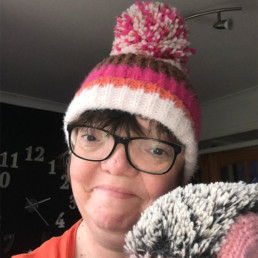
Written by Corinna Richards
An avid crocheter, who also happens to teach, train and lead.
“You never get a second chance to make a first impression.”
— Andrew Grant.
Whether Oscar Wilde or Will Rogers said it first, isn’t for this purpose particularly important. What any student or teacher with a facial disfigurement will tell you, is that it’s true. And the experience of that is hugely important. It’s always been true, but in our “beauty bias” society, looking different – whatever that difference may be, is a big deal. Having a facial or ‘visible difference’ can be excruciating. Our physical appearance matters in first impressions. I’m not saying it should, but from my experience it does.
I blog about this from two perspectives. Firstly, as a person with a congenital facial disfigurement who works in Education and secondly as an EdD student. I’ve just turned 50, and “back in the day” plastic surgery wasn’t as developed as it is now. I had my first plastic, corrective surgery at the age of 11, so I spent my primary school years looking very different. My skull fused together in the womb prematurely which caused my eyes to be extremely wide set and for my nose to be virtually flat with two small nostrils. You can imagine…
However, like everyone, I’ve adapted, over-compensated and fought my way back. I always wanted to teach and that’s what I’ve always done. Apart from three terms in suburbia I’ve always taught in inner city London and only once did I have any issues regarding my face from a pupil. I loved and still do, the diversity of the inner-city, the children were remarkably accepting of my appearance, we were all shapes and sizes together, the issue of ‘normal’ just never seemed too prevalent. The same couldn’t be said for the parents! The suspicion of my appearance was always there, in some heated exchanges a name regarding my appearance would slip out (yawn… I’ve never heard that one before…) and I’ve even had some parents ask my secretary what is wrong with my face! (One of the many reasons I prefer children to adults!)
But last year, I had a bit of a shock.
I am in the third of year of EdD at UEL and I am studying the lived experience of Imposter Phenomenon in Teacher Educators. It’s really interesting, but it wasn’t my first choice. Initially, I wanted to study IP in teachers with visible differences. I couldn’t find any. I didn’t know any. I didn’t know any teachers with facial burns, or severe acne, or disfiguring birthmarks or craniosynostosis… statistically they must exist (I am for one)… but where are they? I then thought about all the pupils I have taught over nearly 30 years… lots of differences, but when did I teach a child who was like me? I don’t think I have. Where are these children and where are the teachers?
Recently, in an updated version of Malory Towers, a young actor, Beth Bradfield, with a visible difference joined the cast, but how often do we see actors with facial burns or scars? Possibly in James Bond, but then of course, only as the villain. I attended my first DEI event last weekend, it was brilliant. Representation matters. Yes, it does. So how do I help other people like me have the courage to stand in front of groups of people and teach. I spent decades of my life trying to hide my face. I was desperate to make my visible difference invisible. It seems like I might not be the only one.
For more information visit:
‘Changing Faces’:
The Katie Piper Foundation: www.katiepiperfoundation.org.uk
Headlines:

